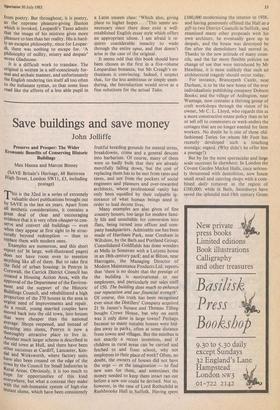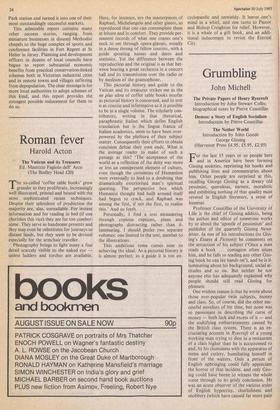Save buildings and save money
John Jolliffe
Preserve and Prosper: The Wider Economic Benefits of Conserving Historic Buildings Max Hanna and Marcus Binney
(SAVE Britain's Heritage, 68 Battersea High Street, London SW I1, £3, including postage) This is the 32nd in a series of extremely valuable short publications brought out by SAVE in the last six years. Apart from all aesthetic considerations, it contains a great deal of clear and encouraging evidence that it is very often cheaper to con- serve and convert old buildings — even when they appear at first sight to be struc- turally beyond redemption — than to replace them with modern ones.
Examples are numerous, and this short report (of 36 large, well-illustrated pages) does not have room even to mention anything like all of them. But to take first the field of urban housing: in Penryn in Cornwall, the Carrick District Council has created a Housing Action Area, with the approval of the Department of the Environ- ment and the support of the Historic Buildings Council, and rehabilitated a high Proportion of the 270 houses in the area in urgent need of improvements and repair. As a result, young married couples have Moved back into the old town, into houses that were cheaper than the national average. Shops reopened, and instead of decaying into slums, Penryn is now a thoroughly attractive place to live in. Another much larger scheme is described in the old town at Hull, and there have been other successes at Cardiff, Lancaster, Ken- dal and Wirksworth, where factory units have also been created on the edge of the town by the Council for Small Industries in Rural Areas. Obviously, it is too much to hope for opportunities of this kind everywhere, but what a contrast they make with the sub-humanist system of high-rise instant slums, which have been consistently
fruitful breeding grounds for mental stress, breakdowns, crime and a general descent into barbarism. Of course, many of them were so badly built that they are already mercifully falling down, but the cost of replacing them has to be met from rates and taxes, and not from the pockets of social engineers and planners and over-rewarded architects, whose professional vanity has only been equalled by their culpable ig- norance of what human beings need in order to lead decent lives.
Many examples are also given of fine country houses, too large for modern fami- ly life and unsuitable for conversion into flats, being turned into offices and com- pany headquarters. Admirable use has been made of Hartham Park, near Corsham in Wiltshire, by the Bath and Portland Group; Consolidated Goldfields has done wonders at Melts in Somerset with a Lutyens house in an 18th-century park; and at Bilton, near Harrogate, the Managing Director of Modern Maintenance Products Ltd. reports that 'there is no doubt that the prestige of the building is motivational to our employees, and particularly our sales staff of 150. The building does much to enhance our reputation and our financial strength'. Of course, this truth has been recognised ever since the Distillers' Company acquired 21 St James's Square and Thomas Tilling bought Crewe House, but why on earth was it only done in large towns? Perhaps because so many suitable houses were hid- den away in parks, often at sonic distance from towns and villages. But the minibus is not exactly a recent invention, and if children in rural areas can be carried and fetched to and from school, why not employees to their place of work? Often, no doubt, the owners of houses did not have the urge — or the imagination — to find new uses for them, and sometimes the money needed to keep them intact ran out before a new use could be devised. Not so, however, in the case of Lord Rothschild at Rushbrooke Hall in Suffolk. Having spent £100,000 modernising the interior in 1938, and having generously offered the Hall as a gift to two District Councils in Suffolk, and examined many other proposals with his own architect, he eventually gave up in despair, and the house was destroyed by fire after the demolishers had moved in. Thanks to the new attitude of many coun- cils, and the far more flexible policies on change of use that were introduced by Mr Heseltine, it is most unlikely that such an architectural tragedy should occur today,
For instance, Brancepeth Castle, near Durham, is to be the new home of the ever individualistic publishing company Dobson Books; and the village of Ardington, near Wantage, now contains a thriving group of craft workshops through the vision of its owner, Mr C. L. Lloyd, who regards this as a more constructive estate policy than to let or sell off to commuters or week-enders the cottages that are no longer needed for farm workers. No doubt he is one of those old- fashioned Tories for whom Mr Foot has recently developed such a touching nostalgic regard. (Why didn't he offer him a peerage?)
But by far the most spectacular and large scale successes lie elsewhere. In London the Covent Garden Market Halls, once serious- ly threatened with demolition, now house small retail and catering shots with a com- bined daily turnover in the region of £100,000; while in Bath, Sainsburys have saved the splendid mid-19th century Green
Park station and turned it into one of their most outstandingly successful markets.
This admirable report contains many other success stories, ranging from miniature businesses in disused Methodist chapels to the huge complex of sports and conference facilities in Fort Regent at St Helier in Jersey. Planning and development officers in dozens of local councils have begun to report substantial economic benefits from practical conservation-linked schemes both in Victorian industrial cities and in remote towns and villages suffering from depopulation. The clear message is for more local authorities to adopt schemes of this kind, and this report provides the strongest possible inducement for them to do so.







































 Previous page
Previous page